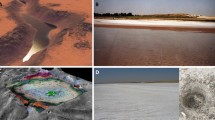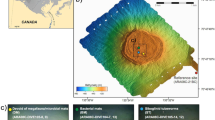Abstract
Microbial expansion following faunal mass extinctions in Earth history can be studied by petrographic examination of microbialites (microbial crusts)1,2 or well-preserved organic-walled microbes3. However, where preservation is poor, quantification of microbial communities can be problematic. We have circumvented this problem by adopting a lipid biomarker-based approach to evaluate microbial community changes across the Permo/Triassic (P/Tr) boundary at Meishan in South China. We present here a biomarker stratigraphic record showing episodic microbial changes coupled with a high-resolution record of invertebrate mass extinction. Variation in the microbial community structure is characterized by the 2-methylhopane (2-MHP) index (a ratio of the abundance of cyanobacterial biomarkers to more general bacterial biomarkers). Two episodes of faunal mass extinction were each preceded by minima in the 2-MHP index, followed by strong maxima, likely reflecting microbial responses to the catastrophic events that caused the extinction and initiated ecosystem changes. Hence, both cyanobacterial biomarker and invertebrate fossil records provide evidence for two episodes of biotic crisis across the P/Tr boundary.
This is a preview of subscription content, access via your institution
Access options
Subscribe to this journal
Receive 51 print issues and online access
$199.00 per year
only $3.90 per issue
Buy this article
- Purchase on Springer Link
- Instant access to full article PDF
Prices may be subject to local taxes which are calculated during checkout


Similar content being viewed by others
References
Lehrmann, D. J. et al. Permian-Triassic boundary sections from shallow-marine carbonate platforms of the Nanpanjiang Basin, south China: Implications for oceanic conditions associated with the end-Permian extinction and its aftermath. Palaios 18, 138–152 (2003)
Sheehan, P. M. & Harris, M. T. Microbialite resurgence after the Late Ordovician extinction. Nature 430, 75–78 (2004)
Knoll, A. H. & Walter, M. W. Latest Proterozoic stratigraphy and Earth history. Nature 356, 673–678 (1992)
Summons, R. E., Jahnke, L. L., Hope, J. M. & Logan, G. A. 2-Methylhopanoids as biomarkers for cyanobacterial oxygenic photosynthesis. Nature 400, 554–557 (1999)
Simonin, P., Jurgens, U. J. & Rohmer, M. Bacterial triterpenoids of the hopane series from the prochlorophyte Prochlorothrix hollandica and their intracellular localization. Eur. J. Biochem. 241, 865–871 (1996)
Rohmer, M., Bouvier-Nave, P. & Ourisson, G. Distribution of hopanoid triterpenes in prokaryotes. J. Gen. Microbiol. 130, 1137–1150 (1984)
Rohmer, M., Bisseret, P. & Neunlist, S. in Biological Markers in Sediments and Petroleum (eds Moldowan, J. M., Albrecht, P. & Philp, R. P.) 1–17 (Prentice Hall, New Jersey, 1992)
Jin, Y. G. et al. Pattern of marine mass extinction near the Permian-Triassic boundary in South China. Science 289, 432–436 (2000)
Yin, H., Zhang, K., Tong, J., Yang, Z. & Wu, S. The Global Stratotype Section and Point (GSSP) of the Permian-Triassic boundary. Episodes 24, 102–114 (2001)
Brocks, J. J., Buick, R., Summons, R. E. & Logan, G. A. A reconstruction of Archean biological diversity based on molecular fossils from the 2.78 to 2.45 billion-year-old Mount Bruce Supergroup, Hamersley Basin, Western Australia. Geochim. Cosmochim. Acta 67, 4321–4335 (2003)
Wignall, P. B. & Hallam, A. Griesbachian (Earliest Triassic) palaeoenvironmental changes in the Salt Range, Pakistan and Southeast China and their bearing on the Permian-Triassic mass extinction. Palaeogeogr. Palaeoclimatol. Palaeoecol. 102, 215–237 (1993)
Yin, H. et al. The Palaeozoic-Mesozoic Boundary, Candidates of Global Stratotype Section and Point of the Permian-Triassic Boundary (China Univ. of Geosciences Press, Wuhan, 1996)
Lai, X., Wignall, P. & Zhang, K. Palaeoecology of the conodonts Hindeodus and Clarkina during the Permian-Triassic transitional period. Palaeogeogr. Palaeoclimatol. Palaeoecol. 171, 63–72 (2001)
Yin, H. & Tong, J. Multidisciplinary high-resolution correlation of the Permian-Triassic boundary. Palaeogeogr. Palaeoclimatol. Palaeoecol. 143, 199–212 (1998)
Hallam, A. & Wignall, P. Mass Extinctions and their Aftermath (Oxford Univ. Press, Oxford, 1997)
Valentine, J. W. & Jablonski, D. Mass extinctions: sensitivity of marine larval types. Proc. Natl Acad. Sci. USA 83, 6912–6914 (1986)
Dionisio-Pires, L. M., Jonker, R. R., Van Donk, E. & Laanbroek, H. J. Selective grazing by adults and larvae of the zebra mussel (Dreissena polymorpha): application of flow cytometry to natural seston. Freshwat. Biol. 49, 116–126 (2004)
Erwin, D. H. The end-Permian mass extinction. Annu. Rev. Ecol. Syst. 21, 495–516 (1990)
Racki, G. Silica-secreting biota and mass extinctions: survival patterns and processes. Palaeogeogr. Palaeoclimatol. Palaeoecol. 154, 107–132 (1999)
Keeling, M. J., Wilson, H. B. & Pacala, S. W. Reinterpreting space, time lags, and functional responses in ecological models. Science 290, 1758–1761 (2000)
Erwin, D. H. Lessons from the past: biotic recoveries from mass extinction. Proc. Natl Acad. Sci. USA 98, 5399–5403 (2001)
Vecoli, M. & Le Herisse, A. Biostratigraphy, taxonomic diversity and patterns of morphological evolution of Ordovician acritarchs (organic-walled microphytoplankton) from the northern Gondwana margin in relation to palaeoclimatic and palaeogeographic changes. Earth-Sci. Rev. 67, 267–311 (2004)
Rampino, M. R. & Adler, A. C. Evidence for abrupt latest Permian mass extinction of foraminifera: results of tests for the Signor-Lipps effect. Geology 26, 415–418 (1998)
Mastin, B. J., Rodger, J. H. Jr & Deardorff, T. L. Risk evaluation of cyanobacteria-dominated algal blooms in a North Louisiana reservoir. J. Aquatic Ecosyst. Stress Recovery 9, 103–114 (2002)
Retallack, G. J. Search for evidence of impact at the Permian-Triassic boundary in Antarctica and Australia. Geology 26, 979–982 (1998)
Ward, P. D., Montgomery, D. R. & Smith, R. Altered river morphology in South Africa related to the Permian-Triassic extinction. Science 289, 1740–1743 (2000)
Yang, Z. Y. et al. Permo-Triassic Events of South China (Geological Publishing House, Beijing, 1993)
Erwin, D. H., Bowring, S. A. & Jin, Y. in Special Paper 356, Catastrophic Events and Mass Extinctions: Impacts and Beyond (eds Koeberl, C. & MacLeod, K. G.) 363–383 (Geological Society of America, Boulder, 2002)
Acknowledgements
We thank F. Yang, S. Wu, G. Zhu, J. Huang, Y. Yi and J. Yu for field assistance, L. Lu, D. Jiao and X. Huang for sample processing, and M. Benton for constructive comments on the manuscript. The authors thank I. D. Bull and R. Berstan for their technical assistance and the NERC for funding the Bristol node of the Life Sciences Mass Spectrometry Facility (http://www.chm.bris.ac.uk/lsmsf/index.html). This work was supported by National Natural Science Foundation (H. Y.), NCET programme of Ministry of Education of China (S. X.) and the Lab of Bio- and Environmental Geology in China University of Geosciences.
Author information
Authors and Affiliations
Corresponding author
Ethics declarations
Competing interests
The authors declare that they have no competing financial interests.
Supplementary information
Supplementary Table S1
This table shows some organic geochemical data from section B at Meishan. (DOC 77 kb)
Supplementary Table S2
This table shows the faunal species data at different horizons from Meishan sections, including the number of extinction species, survivors and originating species, and the calculated faunal extinction probability. (DOC 33 kb)
Rights and permissions
About this article
Cite this article
Xie, S., Pancost, R., Yin, H. et al. Two episodes of microbial change coupled with Permo/Triassic faunal mass extinction. Nature 434, 494–497 (2005). https://doi.org/10.1038/nature03396
Received:
Accepted:
Issue Date:
DOI: https://doi.org/10.1038/nature03396
This article is cited by
-
Genetics re-establish the utility of 2-methylhopanes as cyanobacterial biomarkers before 750 million years ago
Nature Ecology & Evolution (2023)
-
Plate Tectonics: The Stabilizer of Earth’s Habitability
Journal of Earth Science (2023)
-
Early and late phases of the Permian–Triassic mass extinction marked by different atmospheric CO2 regimes
Nature Geoscience (2022)
-
Early Triassic microbialites from the Changxing Region of Zhejiang Province, South China
Journal of Palaeogeography (2019)
-
Bacterial diversification through geological time
Nature Ecology & Evolution (2018)
Comments
By submitting a comment you agree to abide by our Terms and Community Guidelines. If you find something abusive or that does not comply with our terms or guidelines please flag it as inappropriate.



